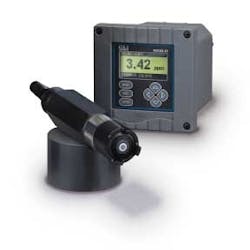GLI International has introduced a Ross Cell Technology dissolved oxygen sensor that features a replaceable membrane cartridge. The sensor addresses the inherent measurement problems of electrode contamination, electrolyte depletion, and membrane coating found in some other systems.
Most continuous dissolved oxygen measurement systems in today's marketplace use either electrolytic or galvanic type measurement techniques.
In a basic galvanic cell, the oxygen content of the electrolyte is brought into equilibrium with the sample oxygen content. The electrodes are polarized by an induced voltage, causing an electrochemical reaction when the oxygen comes into contact with the electrodes. This reaction creates a current flow through the electrolyte, the magnitude of which is proportional to the oxygen concentration in the electrolyte.
This technique depends on the reduction of oxygen molecules to generate a measurement voltage, making it susceptible to contamination of the electrodes and electrolyte. If a contaminating material permeates the membrane, it will cause the cell potential to shift. This shift will be interpreted falsely as a change in dissolved oxygen concentration.
Another problem occurs at low oxygen concentration levels. Since the output of a galvanic cell is linearly proportional to the amount of oxygen present, the potential for errors at low oxygen levels increases due to a low signal-to-noise ratio. Finally, the anode electrode will be consumed due to the electrochemical reaction necessary for the dissolved oxygen measurement.
The electrolytic measurement technique typically uses a polarographic cell, which requires a polarization voltage to be applied to the electrodes. As long as this voltage is maintained at a constant level, the cell will not be as susceptible to contamination of the electrodes and electrolyte. If a contaminating material does permeate the membrane, the cell potential will not shift.
A polarographic cell measures the current flow that results from reduction of the oxygen molecules in the cell. Since this current flow is linearly proportional to the amount of oxygen present, potential for errors at low oxygen levels is reduced. The anode electrode is not consumed by the electrochemical reaction.
The new GLI dissolved oxygen sensor, Model 5600-series, uses three-electrode polarographic Ross Cell technology that consists of a platinum working electrode (cathode), a platinum counter electrode (anode), and a silver reference electrode.
The oxygen that is dissolved in the process diffuses through an oxygen permeable membrane, and is reduced at the working electrode. The reverse of this reaction occurs at the counter electrode. Because the Ross cell generates as much oxygen as it consumes, it operates at equilibrium with no net difference in consumed oxygen.
Measurement at equilibrium minimizes sensor maintenance and extends membrane cartridge life. The accuracy of the measurement is not affected by partial membrane fouling, so the Ross Cell technology sensor will provide accurate readings as long as the membrane is not completely fouled. Measurement at equilibrium also eliminates electrolyte depletion and oxide formation that would normally consume the electrodes.
The GLI DO sensor is covered by a 30-month pro-rated warranty. The replaceable membrane cartridge of the sensor consists of a pre-installed, semi-permeable membrane, electrolyte, and electrodes and is guaranteed for one year from date of shipment.




